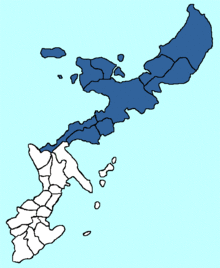

Yambaru (山原) is the Okinawan and Kunigami name given to the forested northern part of Okinawa Island in Japan. Spanning the northern villages of Higashi, Kunigami, and Ōgimi, Yambaru contains some of the last large surviving tracts of subtropical rainforest in Asia, with many endemic species of flora and fauna. Many southerners fled to the area for refuge during the Battle of Okinawa. In 2016, Yambaru National Park was established and the area was included in a submission for inscription on the UNESCO World Heritage List.
Yambaru currently contains the 7,500 ha US Jungle Warfare Training Centre at Camp Gonsalves. As of 2010 there were twenty-two helipads in the training area with a further seven planned within two of the best preserved areas. Issues relating to the location of helipads delayed the designation as a National Park. Threatened by clearcutting and the removal of undergrowth, various endemic species are facing an imminent extinction crisis. The US Marine Corps has noted that 'to continue to perform realistic military training activities, these habitats must be maintained.'
Biodiversity

According to the WWF, Yambaru is the habitat of over four thousand species, with eleven animals and twelve plants peculiar to the area. Many of these are threatened species on the IUCN Red List and 177 feature on the Red List of the Ministry of the Environment. Rare species include the flightless Okinawa rail (Yambaru kuina in Japanese), Okinawa woodpecker (Special Natural Monument), Ryukyu robin, Amami woodcock, Ryukyu black-breasted leaf turtle, Anderson's crocodile newt, Ishikawa's frog, Holst's frog, Namiye's frog, Ryukyu long-tailed giant rat, and Muennink's spiny rat. All these species, with the exception of the Ryukyu robin, are classified as endangered; the Muennink's spiny rat, the Okinawa woodpecker, and Yambaru whiskered bat being critically endangered.
The Okinawa woodpecker in particular is threatened both by the presence of American Ospreys from the US Marine bases on the island and by the construction of six new helipads in the forest.
Conservation and tourism
The Yambaru Wildlife Conservation Centre (Ufugi Nature Museum) (やんばる野生生物保護センター (ウフギー自然館)) opened in 1999 to increase understanding of the area; in 2010 it reopened after renovation. The area is being promoted by Okinawa Prefecture for ecotourism.
See also
- Okinawa Yambaru Seawater Pumped Storage Power Station
- Issue of US bases in Okinawa
- Ryūkyū Kingdom
- National Parks in Japan
- World Heritage Sites in Japan
- Ogasawara Islands
References
- ^ "Ufugi Nature Museum" (PDF). Yambaru Wildlife Conservation Centre. Retrieved 19 February 2012.
- ^ "United States Marine Corps Installations Natural Resource Program: Camp Smedley D. Butler, MCB" (PDF). United States Marine Corps. Retrieved 19 February 2012.
- Tanji Miyumi (2006). Myth, Protest and Struggle in Okinawa. Routledge. p. 164. ISBN 978-0-415-36500-0.
- "Wild forest area in northern Okinawa designated as 33rd national park". The Japan Times. 15 September 2016. Retrieved 8 October 2016.
- "Amami-Oshima Island, Tokunoshima Island, the northern part of Okinawa Island and Iriomote Island". UNESCO. Retrieved 8 October 2016.
- ^ "Japan prepares to nominate more sites for registration on global list". The Japan Times. 1 January 2012. Retrieved 19 February 2012.
- "Govt to select candidate for World Natural Heritage". Yomiuri Shimbun. 18 February 2012. Retrieved 19 February 2012.
- ^ Chapron, Guillaume (et al.) (4 October 2010). "Biodiversity 100: actions for Asia". The Guardian. Retrieved 19 February 2012.
- ^ "No Military Helipads in Yambaru Forest" (PDF). World Wide Fund for Nature. Retrieved 19 February 2012.
- Itō Yosiaki (et al.) (2000). "Imminent extinction crisis among the endemic species of the forests of Yambaru, Okinawa, Japan". Oryx. 34 (4). Cambridge University Press: 305–316. doi:10.1046/j.1365-3008.2000.00136.x.
- "Rare species in Yambaru". Okinawa Prefecture. Archived from the original on 2009-09-09. Retrieved 19 February 2012.
- "Dendrocopos noguchii". IUCN. Retrieved 19 February 2012.
- "Myotis yanbarensis". IUCN. Retrieved 19 February 2012.
- "Ospreys drive Okinawa woodpeckers from Takae; watchers warn".
- "Gov't seeks to register Okinawa forest utilized as US military training field as world heritage site - @JapanPress_wky".
- "Helipad project resumes in Okinawa after barrier removed:The Asahi Shimbun". www.asahi.com. Archived from the original on 2016-07-23.
- "Wildlife Conservation Centres in Japan" (in Japanese). Ministry of the Environment. Retrieved 19 February 2012.
- Cook, Chris (28 March 2008). "Finding the real Okinawa in Yambaru". The Japan Times. Retrieved 19 February 2012.
- Ishimori Shuzo. "Ecotourism in Okinawa: Yambaru". Okinawa Prefecture. Archived from the original on 2011-10-30. Retrieved 19 February 2012.
External links
- Map of Yambaru (area marked in green on smaller map)
- State of Japan’s Environment at a Glance: Extinct and Endangered Species Listed in the Red Data Book
Category: